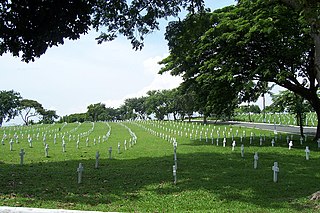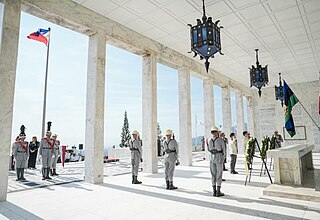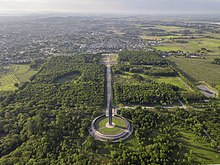
The Philippine Scouts (Filipino: Maghahanap ng Pilipinas/Hukbong Maghahanap ng Pilipinas) was a military organization of the United States Army from 1901 until after the end of World War II. These troops were generally Filipinos and Filipino-Americans assigned to the United States Army Philippine Department, under the command of American commissioned officers (though a handful of Filipino Americans received commissions from the United States Military Academy). Philippine Scout units were given the suffix "(PS)", to distinguish them from other U.S. Army units.

Tarlac, officially the Province of Tarlac, is a landlocked province in the Philippines located in the Central Luzon region. Its capital is the city of Tarlac. It is bounded on the north by the province of Pangasinan, Nueva Ecija on the east, Zambales on the west and Pampanga in the south. The province comprises three congressional districts and is subdivided into 17 municipalities and one city, Tarlac City, which is the provincial capital.

The Bataan Death March was the forcible transfer by the Imperial Japanese Army of 75,000 American and Filipino prisoners of war (POW) from the municipalities of Bagac and Mariveles on the Bataan Peninsula to Camp O'Donnell via San Fernando.

Libingan ng mga Bayani is a national cemetery within Fort Bonifacio in Taguig, Philippines.

Capas, officially the Municipality of Capas, is a 1st class municipality in the province of Tarlac, Philippines, and one of the richest towns in the province. The town also consists of numerous subdivisions and exclusive villages.

Mount Samat National Shrine or Dambana ng Kagitingan is a historical shrine located near the summit of Mount Samat in the town of Pilar, Province of Bataan, in the Philippines. The memorial shrine complex was built to honor and remember the gallantry of Filipino and American soldiers who fought against the Imperial Japanese Army during World War II.

Camp O'Donnell is a current military base and former United States military reservation in the Philippines located on Luzon island in the municipality of Capas in Tarlac. It housed the Philippine Army's newly created 71st Division and after the Americans' return, a United States Army camp. During World War II, the reservation was used as a prisoner-of-war camp for Filipino and American soldiers captured by Japan during its successful invasion of the Philippines. About 60,000 Filipino and 9,000 Americans were housed at the camp. During the few months in 1942 that Camp O'Donnell was used as a prisoner-of-war camp, about 20,000 Filipinos and 1,500 Americans died there of disease, starvation, neglect, and brutality.

The Day of Valor, officially known as Araw ng Kagitingan, is a national observance in the Philippines which commemorates the fall of Bataan to Japanese troops during World War II. The day is officially celebrated every April 9, the start of the Bataan Death March, although the date was moved on several occasions to avoid it from coinciding with the observance of the Holy Week in the country, especially the Easter Triduum and Easter Sunday, such as in 2009 and 2023.

Benigno de Guzman Tabora was a Filipino American veteran of both World War II and the Korean War. Tabora was one of the last of an increasingly dwindling group of veterans who survived the Bataan Death March in May 1942 after the Japanese captured the Philippines during World War II. He spent eight months as a prisoner of war in a Japanese internment camp. Tabora served in the military intelligence during his 31 years in the Army.

In the United States, National POW/MIA Recognition Day is observed on the third Friday in September. It honors those who were prisoners of war (POWs) and those who are still missing in action (MIA). It is most associated with those who were POWs during the Vietnam War. National Vietnam War Veterans Day is March 29, the date in 1973 when the last US combat troops departed the Republic of Vietnam.

The 41st Infantry Division was a division of the Philippine Army under the United States Army Forces in the Far East (USAFFE).

Mount Samat is a mountain in the town of Pilar, Bataan, [Philippines]]. Located near its summit is the Mount Samat National Shrine, a national shrine dedicated to the fallen Filipino and American fallen during World War II.

Clark Veterans Cemetery is located in Clark Freeport Zone, Angeles City, Philippines. The cemetery is the burial place for thousands of mainly American veterans and Filipino Scouts who served in the United States Army, and who died in conflicts other than World War II or on military bases in the Philippines.

The U.S. Naval Radio Station, Tarlac, also known as the U.S. Naval Radio Transmitter Facility, Capas, Tarlac, was a remote unit of the U.S. Naval Communication Station Philippines (NavComStaPhil), located at 15.354114°N 120.536048°E, near the town of Capas, Tarlac Province, Luzon, Republic of the Philippines. The sole purpose of the station was to provide short-wave radio transmission capability for its parent communication station, that is, to be the radio voice for NavComStaPhil. It provided wide-area radio broadcasts, as well as dedicated, point-to-point radio transmissions to individual U.S. Navy ships in the vicinity of the Philippine Islands.

New Clark City is a planned community currently undergoing development, located within the Clark Special Economic Zone in the towns of Bamban and Capas in Tarlac province, Philippines. It has an area of approximately 9,450 hectares and will accommodate up to 1.2 million people. It is owned and managed by the Bases Conversion and Development Authority (BCDA).

The Cabanatuan American Memorial is a World War II memorial located in Cabanatuan, Nueva Ecija in the Philippines. It is located on the site of what was once Camp Pangatian, a military training camp which operated for twenty years until it was converted into an internment camp for Allied prisoners of war during the Japanese occupation.

The 11th Infantry Division was one the reserve division of the Philippine Army that was mobilized in September 1941 under the United States Army Forces in the Far East (USAFFE).

The Philippines being one of the major theaters of World War II, has commissioned a number of monuments, cemeteries memorials, preserved relics, and established private and public museums, as well as National Shrines, to commemorate battles and events during the invasion, occupation, and liberation of the country. The United States and Japan also has established a number of memorials in the country.

































